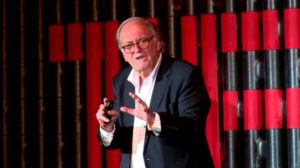Facts: abysmal sales in the supermarket chain, strong competitor activity, decreased customer loyalty.
Guess what, new CEO.
Analysis: old fashion shops, excessive and confusing number of brands, buyer experience an all time low, management practices out of date, huge complacency.
Plans: drastic redesign of shops with focus on customer experience, reduced number of brands, replacement of layers of managers.
Communication to the public:
Type 1. Due to adverse market conditions, we have created a programme of continuous improvement in our supermarkets; we will make it easy for you to shop, we have identified 12 problem areas that we are addressing straight away including giving you more points in the shopping basket.
Type 2: The time has come for us to build a new kind of supermarket, an exciting experience with great prices. We are creating a new concept of shopping, online and in our places. Come and see it for yourself on January 1st. Thanks for being one of the 3 million loyal customers.
Type 1 says: These guys have a big problem and are desperate. 12 areas? I can give them a 13th one. And they are bribing us with more points. I have heard in the news about their troubles. They are reacting by fixing things, but it will be more of the same. Plus the cost of the management consultants!
Type 2 says: These people are into something. I wonder what that may be. They don’t have 3 million customers for nothing. I have heard in the news about their troubles. They are reacting by building something different. Good for them!
Same facts, same analysis, same plans, two frames.
Frame 1 is a fixing frame, a catch up frame, a ‘continuous improvement’ (so where were they before, discontinuous?), a change in the oil in the noisy car. It repeats negatives.
Frame 2 is a building frame, it does not talk about fixing, it does not repeat negatives. It’s intriguing; it’s saying ‘trust me’.
These may be caricatures, but you have seen many Type 1 and Type 2 in your organizational life. Because the facts, the analysis and the plans are the same, the communication is the real differentiator.
I personally feel strongly that we, in management, have over-learnt ‘problem solving’ and equate that to ‘good management’. I think we need to un-learn that, and learn fast the building mode, the building frame.
Any reorganization, big or small; any process and system change, any tackling of serious problems, shortcomings, or other deficits; any ‘transformation’ can be framed as a solving problem or as a building adventure. Building is the one that shapes the future. The other is a rear mirror strategy that will always need to catch up.
Unless you think in your heart that you are not building anything (a situation for which I would have equal dose of admiration for your frankness, and being sorry for your declared prolonged agony) always try the building narrative. Entire tribes, nations, and movements have used it. Why not you?
PS. In the building plans, include all the fixing that needs to be done, but only the ones that shape the new thing. Fix, but don’t talk too much about it.
________________________________________________________________________________________________
To find out more or to discuss further contact us.




Would you like to comment?